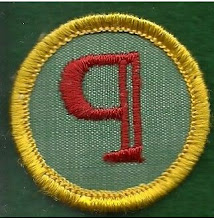Writers live in a curious world,
where everyone has an idea for a story (see last week's blog) -- or it feels like every story that could be told has been told. Nonetheless, we keep
writing.
Web sites like Writers Write and
Grammar Girl abound with writing tips, and ideas. I use a couple of writing
prompt sites. The Writer's Digest site is great -- and for quick inspiration I
like CreativeWritingPrompts.com -- rollover the numbers on the site with your
mouse and a prompt pops up. #192: Why would a pastry chef refuse to move to
another town? (Sweeney Todd immediately popped into my
mind!)
There is no shortage of great ideas -- the writer's CRAFT is the difference. Often the craft is finding a new way to tell a familiar story; or a familiar way to tell a familiar story -- as a friend who writes romance novels says, "I give my readers the stories they expect."
But there is also the unexpected.
How do you give Shakespeare -- specifically "Hamlet" -- a twist? Tom Stoppard does it with Rosencrantz and Guildenstern are Dead. A line near the end of "Hamlet" triggers the entire play, first produced in 1966 (and made into a film in 1990). This play is interwoven with scenes from Hamlet; often with the two protagonists looking on in amazement at the action on the stage. I often taught the two plays together and one of my students said, "That Stoppard guy, he's just samplin' Shakespeare, right?"
Right! Exactly.
Judy Garland et al in "The Wizard of
Oz" (1939) was the only Wizard of Oz for a very long time. Then the movie was remade as The Wiz --
an “urbanized retelling” with an all-Black cast, first as a play (1975) and a
movie (1978, Motown Productions with Diana Ross, Michael Jackson, Nipsy Russell, Lena
Horne, and Richard Pryor). The movie was a flop, though it offered up one hit tune ("Ease On Down the Road").
There were no more Oz stories until Gregory McGuire published Wicked: The Life and Times of the Wicked Witch of the West (1995). In 1998, Steven Schwartz acquired the stage
rights and worked with Winnie Holzman to develop the mega award-winning musical Wicked: the Untold Story of the Witches of Oz (debut 2003).
"Wicked" the musical does reference the 1939 film – it almost has to because
“The Wizard of Oz is deeply embedded into our popular culture.
Occasionally, we get two interpretations of the same story, almost at the same time -- for instance, Dangerous Liaisons (1988) and
Valmont (1989) are two movies based on the same book: Chloderos Laclos' 1782 (yes, 1782) novel "Les Liaisons Dangereuses". Though “Dangerous Liasons” is the
better-known of the two, “Valmont” is preferred by film buffs. For a comparison of the two see The Clever Pup.
And... vampires. Audiences never
seem to tire of vampire stories. How many ways can the story be told? The
original Nosterafu (1922) still stands; and in recent memory, Bram Stoker's Dracula (1992), Interview with the Vampire: The Vampire Chronicles, (1994) Buffy the Vampire Slayer (1997-2003) and the Twilight Series, books
and movies (2005-present) have all covered familiar ground in very different ways. And the vampire stories just keep coming -- Florence Wilson write Teenage Vampire when she was fourteen years old...

No comments:
Post a Comment